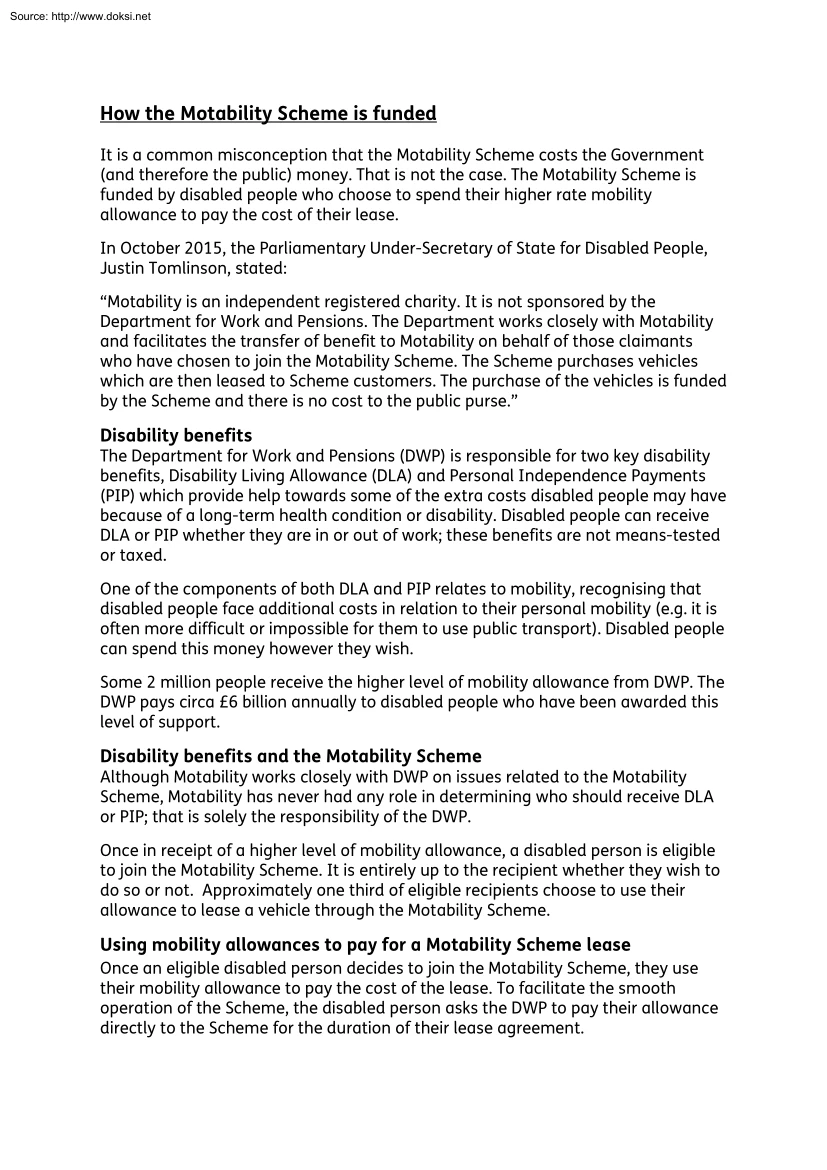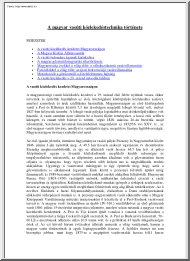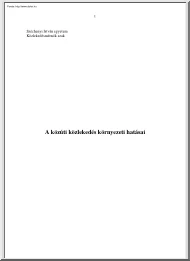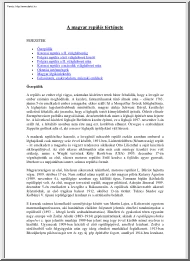Datasheet
Year, pagecount:2017, 2 page(s)
Language:English
Downloads:2
Uploaded:November 11, 2019
Size:471 KB
Institution:
-
Comments:
Attachment:-
Download in PDF:Please log in!
Comments
No comments yet. You can be the first!Most popular documents in this category
Content extract
Source: http://www.doksinet How the Motability Scheme is funded It is a common misconception that the Motability Scheme costs the Government (and therefore the public) money. That is not the case The Motability Scheme is funded by disabled people who choose to spend their higher rate mobility allowance to pay the cost of their lease. In October 2015, the Parliamentary Under-Secretary of State for Disabled People, Justin Tomlinson, stated: “Motability is an independent registered charity. It is not sponsored by the Department for Work and Pensions. The Department works closely with Motability and facilitates the transfer of benefit to Motability on behalf of those claimants who have chosen to join the Motability Scheme. The Scheme purchases vehicles which are then leased to Scheme customers. The purchase of the vehicles is funded by the Scheme and there is no cost to the public purse.” Disability benefits The Department for Work and Pensions (DWP) is responsible for two key
disability benefits, Disability Living Allowance (DLA) and Personal Independence Payments (PIP) which provide help towards some of the extra costs disabled people may have because of a long-term health condition or disability. Disabled people can receive DLA or PIP whether they are in or out of work; these benefits are not means-tested or taxed. One of the components of both DLA and PIP relates to mobility, recognising that disabled people face additional costs in relation to their personal mobility (e.g it is often more difficult or impossible for them to use public transport). Disabled people can spend this money however they wish. Some 2 million people receive the higher level of mobility allowance from DWP. The DWP pays circa £6 billion annually to disabled people who have been awarded this level of support. Disability benefits and the Motability Scheme Although Motability works closely with DWP on issues related to the Motability Scheme, Motability has never had any role in
determining who should receive DLA or PIP; that is solely the responsibility of the DWP. Once in receipt of a higher level of mobility allowance, a disabled person is eligible to join the Motability Scheme. It is entirely up to the recipient whether they wish to do so or not. Approximately one third of eligible recipients choose to use their allowance to lease a vehicle through the Motability Scheme. Using mobility allowances to pay for a Motability Scheme lease Once an eligible disabled person decides to join the Motability Scheme, they use their mobility allowance to pay the cost of the lease. To facilitate the smooth operation of the Scheme, the disabled person asks the DWP to pay their allowance directly to the Scheme for the duration of their lease agreement. Source: http://www.doksinet Would making the Motability Scheme smaller or reducing the number of cars available save the Government money? Making changes to the Motability Scheme would not save the Government money as
they do not fund the Motability Scheme. Regardless of how many of the eligible 2 million disabled people choose to join the Motability Scheme, the Government will still pay £6 billion each year to people receiving these mobility benefits. The cost to Government of the relevant disability benefits is therefore £6 billion per annum, regardless of how individuals choose to spend their benefits. Why are ‘Expensive’ cars available on the Motability Scheme? It is important that disabled people are able to choose a vehicle to accommodate their individual needs from the wide range of vehicles available. Some features which may seem like an added extra can offer vital assistance to disabled motorists, such as high seating position to aid entry and exit, power assisted steering, push-button starting and, of course, automatic transmission. Many Motability Scheme customers apply for a larger, and often more expensive, car which requires an Advance Payment to take account of family size and
any equipment they need to transport, such as a folding wheelchair or walking frame. This is often paid with the help of friends and family although it is important to note that DLA and PIP are not means tested and are paid whether the recipient is in or out of work. Each quarter, the total cost of lease for each vehicle available on the Scheme is calculated. Purchase price, resale value, insurance, breakdown and servicing are all included in the overall cost of the lease. If the total cost of a lease is more than the sum of a customer’s disability allowance they will need to make a one-off payment known as an Advance Payment from their own pocket. This payment is not refunded at the end of the lease. Why do people get a new car every three years? The length of Motability Scheme leases is kept under constant review taking account of the price of new cars, the value of second-hand cars, reliability, environmental factors and the other costs included in the lease such as servicing and
maintenance. The most recent review concluded that for standard production vehicles, three year leases currently offer the best possible value for money. Wheelchair Accessible Vehicles (WAVs) are available on a five year lease. As WAVs are tailor-made and built specifically to the requirements of an individual customer, they are generally more expensive than standard cars. Their bespoke nature and complex conversions, such as lowered floors, mean they are more costly to produce, and therefore a five year lease enables us to offer the best possible value for money. In some specific circumstances, customers may be able to extend their lease at the end of their agreement
disability benefits, Disability Living Allowance (DLA) and Personal Independence Payments (PIP) which provide help towards some of the extra costs disabled people may have because of a long-term health condition or disability. Disabled people can receive DLA or PIP whether they are in or out of work; these benefits are not means-tested or taxed. One of the components of both DLA and PIP relates to mobility, recognising that disabled people face additional costs in relation to their personal mobility (e.g it is often more difficult or impossible for them to use public transport). Disabled people can spend this money however they wish. Some 2 million people receive the higher level of mobility allowance from DWP. The DWP pays circa £6 billion annually to disabled people who have been awarded this level of support. Disability benefits and the Motability Scheme Although Motability works closely with DWP on issues related to the Motability Scheme, Motability has never had any role in
determining who should receive DLA or PIP; that is solely the responsibility of the DWP. Once in receipt of a higher level of mobility allowance, a disabled person is eligible to join the Motability Scheme. It is entirely up to the recipient whether they wish to do so or not. Approximately one third of eligible recipients choose to use their allowance to lease a vehicle through the Motability Scheme. Using mobility allowances to pay for a Motability Scheme lease Once an eligible disabled person decides to join the Motability Scheme, they use their mobility allowance to pay the cost of the lease. To facilitate the smooth operation of the Scheme, the disabled person asks the DWP to pay their allowance directly to the Scheme for the duration of their lease agreement. Source: http://www.doksinet Would making the Motability Scheme smaller or reducing the number of cars available save the Government money? Making changes to the Motability Scheme would not save the Government money as
they do not fund the Motability Scheme. Regardless of how many of the eligible 2 million disabled people choose to join the Motability Scheme, the Government will still pay £6 billion each year to people receiving these mobility benefits. The cost to Government of the relevant disability benefits is therefore £6 billion per annum, regardless of how individuals choose to spend their benefits. Why are ‘Expensive’ cars available on the Motability Scheme? It is important that disabled people are able to choose a vehicle to accommodate their individual needs from the wide range of vehicles available. Some features which may seem like an added extra can offer vital assistance to disabled motorists, such as high seating position to aid entry and exit, power assisted steering, push-button starting and, of course, automatic transmission. Many Motability Scheme customers apply for a larger, and often more expensive, car which requires an Advance Payment to take account of family size and
any equipment they need to transport, such as a folding wheelchair or walking frame. This is often paid with the help of friends and family although it is important to note that DLA and PIP are not means tested and are paid whether the recipient is in or out of work. Each quarter, the total cost of lease for each vehicle available on the Scheme is calculated. Purchase price, resale value, insurance, breakdown and servicing are all included in the overall cost of the lease. If the total cost of a lease is more than the sum of a customer’s disability allowance they will need to make a one-off payment known as an Advance Payment from their own pocket. This payment is not refunded at the end of the lease. Why do people get a new car every three years? The length of Motability Scheme leases is kept under constant review taking account of the price of new cars, the value of second-hand cars, reliability, environmental factors and the other costs included in the lease such as servicing and
maintenance. The most recent review concluded that for standard production vehicles, three year leases currently offer the best possible value for money. Wheelchair Accessible Vehicles (WAVs) are available on a five year lease. As WAVs are tailor-made and built specifically to the requirements of an individual customer, they are generally more expensive than standard cars. Their bespoke nature and complex conversions, such as lowered floors, mean they are more costly to produce, and therefore a five year lease enables us to offer the best possible value for money. In some specific circumstances, customers may be able to extend their lease at the end of their agreement





 Just like you draw up a plan when you’re going to war, building a house, or even going on vacation, you need to draw up a plan for your business. This tutorial will help you to clearly see where you are and make it possible to understand where you’re going.
Just like you draw up a plan when you’re going to war, building a house, or even going on vacation, you need to draw up a plan for your business. This tutorial will help you to clearly see where you are and make it possible to understand where you’re going.